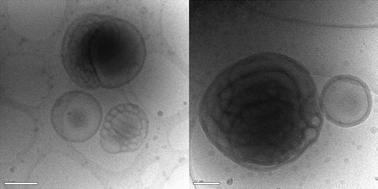Morphological transitions in polymer vesicles upon bilayer swelling with small hydrophobic molecules in water†
Abstract
We show that when unilamellar

- This article is part of the themed collection: Emerging Investigators
* Corresponding authors
a
Department of Chemistry, University of Warwick, Coventry CV4 7AL, UK
E-mail:
s.bon@warwick.ac.uk, David.Cheung@warwick.ac.uk
Web: http://www.bonlab.info
Tel: +44 (0)2476 574009
We show that when unilamellar

 Please wait while we load your content...
Something went wrong. Try again?
Please wait while we load your content...
Something went wrong. Try again?
C. D. J. Parmenter, R. Chen, D. L. Cheung and S. A. F. Bon, Soft Matter, 2013, 9, 6890 DOI: 10.1039/C3SM50184A
To request permission to reproduce material from this article, please go to the Copyright Clearance Center request page.
If you are an author contributing to an RSC publication, you do not need to request permission provided correct acknowledgement is given.
If you are the author of this article, you do not need to request permission to reproduce figures and diagrams provided correct acknowledgement is given. If you want to reproduce the whole article in a third-party publication (excluding your thesis/dissertation for which permission is not required) please go to the Copyright Clearance Center request page.
Read more about how to correctly acknowledge RSC content.
 Fetching data from CrossRef.
Fetching data from CrossRef.
This may take some time to load.
Loading related content
